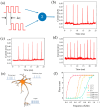Starch-Glycerol-Based Hydrogel Memristors for Bio-Inspired Auditory Neuron Applications
- PMID: 40558722
- PMCID: PMC12192081
- DOI: 10.3390/gels11060423
Starch-Glycerol-Based Hydrogel Memristors for Bio-Inspired Auditory Neuron Applications
Abstract
In the era of artificial intelligence, the demand for rapid and efficient data processing is growing, and traditional computing architectures are increasingly struggling to meet these needs. Against this backdrop, memristor devices, capable of mimicking the computational functions of brain neural networks, have emerged as key components in neuromorphic systems. Despite this, memristors still face many challenges in biomimetic functionality and circuit integration. In this context, a starch-glycerol-based hydrogel memristor was developed using starch as the dielectric material. The starch-glycerol-water mixture employed in this study has been widely recognized in literature as a physically cross-linked hydrogel system with a three-dimensional network, and both high water content and mechanical flexibility. This memristor demonstrates a high current switching ratio and stable threshold voltage, showing great potential in mimicking the activity of biological neurons. The device possesses the functionality of auditory neurons, not only achieving artificial spiking neuron discharge but also accomplishing the spatiotemporal summation of input information. In addition, we demonstrate the application capabilities of this artificial auditory neuron in gain modulation and in the synchronization detection of sound signals, further highlighting its potential in neuromorphic engineering applications. These results suggest that starch-based hydrogel memristors offer a promising platform for the construction of bio-inspired auditory neuron circuits and flexible neuromorphic systems.
Keywords: artificial auditory neuron; gain modulation; hydrogel; memristor; spatiotemporal integration; starch–glycerol; synchronization detection.
Conflict of interest statement
The authors declare that they have no known competing financial interests or personal relationships that could have appeared to influence the work reported in this paper.
Figures






References
-
- Wang W., Danial L., Li Y., Herbelin E., Pikhay E., Roizin Y., Hoffer B., Wang Z., Kvatinsky S. A memristive deep belief neural network based on silicon synapses. Nat. Electron. 2022;5:870–880. doi: 10.1038/s41928-022-00878-9. - DOI
Grants and funding
LinkOut - more resources
Full Text Sources

